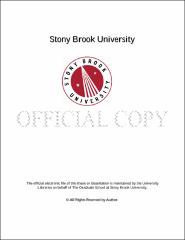| dc.identifier.uri | http://hdl.handle.net/11401/76682 | |
| dc.description.sponsorship | This work is sponsored by the Stony Brook University Graduate School in compliance with the requirements for completion of degree. | en_US |
| dc.format | Monograph | |
| dc.format.medium | Electronic Resource | en_US |
| dc.language.iso | en_US | |
| dc.publisher | The Graduate School, Stony Brook University: Stony Brook, NY. | |
| dc.type | Thesis | |
| dcterms.abstract | In the spring of 1864, Gustave Courbet returned to his home region of Franche-Comté and painted a series of landscapes that took as their subjects various natural points of origin: grottoes, caves, waterfalls, etc. Through his loose and expressive facture, Courbet renders visible in these landscapes the ongoing becoming of the world, investigating the nature of origination and evolution. Courbet’s interest in such subjects comes just two years after the publication of the French translation of Charles Darwin’s On the Origin of Species, which irreversibly unsettled the traditional understanding of humankind’s position within the world. The early years of evolutionary biology made clear the human body’s implication in the history of the earth: no longer could the body be understood in isolation from its environment; rather, it was embedded within a geological history that tied it irrevocably to the earth itself through a common point of origin. This thesis situates these natal or ontogenetic landscapes within the context of the wider dialogue concerning the nature and origins of the body in mid-nineteenth-century France, extending from evolutionary biology to proto-phenomenology, and culminating in Henri Bergson’s notion of creative becoming. Seen through a phenomenological lens informed by the work of Maurice Merleau-Ponty and Elizabeth Grosz, it becomes evident that though Courbet’s landscapes do not take the body itself as their immediate subject, they constitute a reimagining of corporeality as both an epistemological and ontological category, a reordering of the understanding of the body’s place in the world. | |
| dcterms.abstract | In the spring of 1864, Gustave Courbet returned to his home region of Franche-Comté and painted a series of landscapes that took as their subjects various natural points of origin: grottoes, caves, waterfalls, etc. Through his loose and expressive facture, Courbet renders visible in these landscapes the ongoing becoming of the world, investigating the nature of origination and evolution. Courbet’s interest in such subjects comes just two years after the publication of the French translation of Charles Darwin’s On the Origin of Species, which irreversibly unsettled the traditional understanding of humankind’s position within the world. The early years of evolutionary biology made clear the human body’s implication in the history of the earth: no longer could the body be understood in isolation from its environment; rather, it was embedded within a geological history that tied it irrevocably to the earth itself through a common point of origin. This thesis situates these natal or ontogenetic landscapes within the context of the wider dialogue concerning the nature and origins of the body in mid-nineteenth-century France, extending from evolutionary biology to proto-phenomenology, and culminating in Henri Bergson’s notion of creative becoming. Seen through a phenomenological lens informed by the work of Maurice Merleau-Ponty and Elizabeth Grosz, it becomes evident that though Courbet’s landscapes do not take the body itself as their immediate subject, they constitute a reimagining of corporeality as both an epistemological and ontological category, a reordering of the understanding of the body’s place in the world. | |
| dcterms.available | 2017-09-20T16:50:58Z | |
| dcterms.contributor | Rubin, James H | en_US |
| dcterms.contributor | Mather, David S. | en_US |
| dcterms.creator | Georgopulos, Nicole | |
| dcterms.dateAccepted | 2017-09-20T16:50:58Z | |
| dcterms.dateSubmitted | 2017-09-20T16:50:58Z | |
| dcterms.description | Department of Art History and Criticism | en_US |
| dcterms.extent | 55 pg. | en_US |
| dcterms.format | Monograph | |
| dcterms.format | Application/PDF | en_US |
| dcterms.identifier | http://hdl.handle.net/11401/76682 | |
| dcterms.issued | 2016-12-01 | |
| dcterms.language | en_US | |
| dcterms.provenance | Made available in DSpace on 2017-09-20T16:50:58Z (GMT). No. of bitstreams: 1
Georgopulos_grad.sunysb_0771M_12768.pdf: 13988037 bytes, checksum: 24fffcbb4eacc929d27a829925ba102c (MD5)
Previous issue date: 1 | en |
| dcterms.publisher | The Graduate School, Stony Brook University: Stony Brook, NY. | |
| dcterms.subject | Courbet, geology, landscape, origin, phenomenology | |
| dcterms.subject | Art history | |
| dcterms.title | "The Cradle of Things": Origins and Ontogenesis in the Late Landscapes of Gustave Courbet | |
| dcterms.type | Thesis | |

